The E-7A Wedgetail provides one of the most advanced air battlespace management capabilities in the world and the Royal Air Force are rumoured to be interested in it to replace their E-3D Sentry aircraft.

The E-7 Wedgetail is an Airborne Early Warning & Control aircraft with maritime search capabilities, the ability to control unmanned aircraft and intelligence gathering capabilities.
We recently reported that options for the future delivery of the UK’s Airborne Warning and Control capability are being explored, with the focus now on replacing the E-3D Sentry fleet.
We understand that upgrades however are reportedly considered to be expensive. According to Janes here, maintenance is becoming increasingly costly and replacing them instead might be the most cost-effective option.
Some industry commentators are also arguing for a new aircraft type altogether. The large sums of money allocated to upgrading the E-3D fleet should be used to purchase a more advanced off-the-shelf aircraft, a defence analyst has argued. Justin Bronk, Research Fellow, Airpower and Technology, outlines options for replacing the E-3 fleet in his paper ‘The Future of Air C2 and AEW: E-3 Sentry, Threat Technologies and Future Replacement Options’:
“The RAF’s E-3Ds need a £2-billion CSP both to bring them to rough parity with current US and French standards by the mid-2020s and to stretch the fleet out to 2035 in the process. However, the E-3, even in modernised form, is no longer a cutting-edge ABM&S system in a world where proliferating long-range missile systems and emerging non-Western low-observable fighters can force it to stay hundreds of kilometres from contested airspace, placing a higher premium on BLOS communications capacity rather than onboard sensors.
Even when it is able to operate closer to the battlespace, the AN/APY-1/2 mechanically scanned radar array common to all E-3s has significant inherent limitations in terms of its ability to detect low-observable, very slow moving and hypersonic threats, unlike more modern AESA-equipped AWACS types already in service with the US Navy and various air forces around the world. An AESA-equipped ABM&S platform with improved communications node capabilities, based on a commercial-derivative airframe, seems a logical alternative option which could provide the RAF with a more capable and efficient alternative to extending the life of the E-3D over the next 20 years.”
Both the Sentry and Wedgetail are designed to monitor airspace to provide threat detection of adversary aircraft and situational awareness on friendly assets.
The E-7A Wedgetail is based on a Boeing 737-700, with the addition of an advanced Multi-Role Electronically Scanned Array (MESA) radar and 10 mission crew console. They can cover four million square kilometres during a single 10 hour mission according to the Royal Australian Air Force.
“The E-7A Wedgetail represents an entirely new capability for the Australian Defence Force, providing an airborne early warning and control (AEW&C) platform that can gather information from a wide variety of sources, analyse it and distribute it to other air and surface assets.
The E-7A Wedgetail can control the tactical battle space, providing direction for fighter aircraft, surface combatants and land based elements, as well as supporting aircraft such as tankers and intelligence platforms. Based on the 737-700 commercial airliner airframe, the E-7A Wedgetail features advanced multi role electronically scanned radar and 10 state-of-the-art mission crew consoles that are able to track airborne and maritime targets simultaneously.”
As the Second Line of Defense put it, the Wedgetail is designed with ‘the reach rather than range approach’; the MESA radar can be dialled up in terms of energy and focused in terms of direction on priority scan areas. As one Northrop Grumman engineer reportedly put it:
“There is a fundamental shift operationally in terms of how one uses the Wedgetail versus the AWACS. You no longer are limited or defined by a 360 degree rotator. You are able to configure how much power you want to put into your radar reach; it is configurable to the mission. The integrated IFF and radar functionality also allows the system to reach much greater than other systems into the battlespace to shape greater situational awareness in the battlespace. You can put the energy in the mission area where you have the highest priority.”
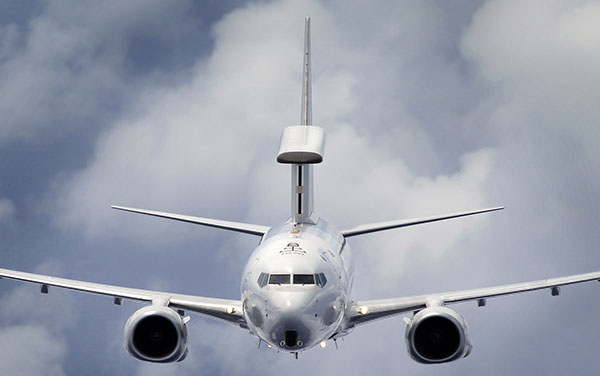
The L-band electronically scanned AEW and surveillance radar is located on a dorsal fin on top of the fuselage, dubbed the “top hat”, and is designed for minimal aerodynamic effect.
The system provides 360 degree coverage and is capable of simultaneous air and sea search, fighter control and area search, with a maximum range of over 600km (look-up mode). When operating in look-down mode against fighter-sized target, the maximum range is in excess of 370 km according to Boeing. When used against maritime targets, the maximum range is over 240km for frigate-sized targets. MESA is capable of simultaneously tracking 180 targets and conducting 24 intercepts. Back in 2009, Boeing even demonstrated control of three ScanEagle unmanned aircraft from a Wedgetail.
In addition, the radar antenna array is also doubled as an ELINT (that’s a form of covert intelligence-gathering by electronic means) array, with a maximum range of over 850 km at 9,000 metre altitude.
Wedgetail looks to be maturing nicely in Australian hands with the major early teething troubles now ironed out. It’s also currently undergoing a major programme of further upgrades, due to be completed in 2022 that we reported on here.
Back in 2014, a Wedgetail conducted the first Australian sortie over Iraq supporting coalition forces conducting airstrikes against Islamic State. The next year, another performed the longest Australian command and control mission in a war zone during a 17-hour, 6-minute combat mission, requiring two air-to-air refuellings to stay aloft.
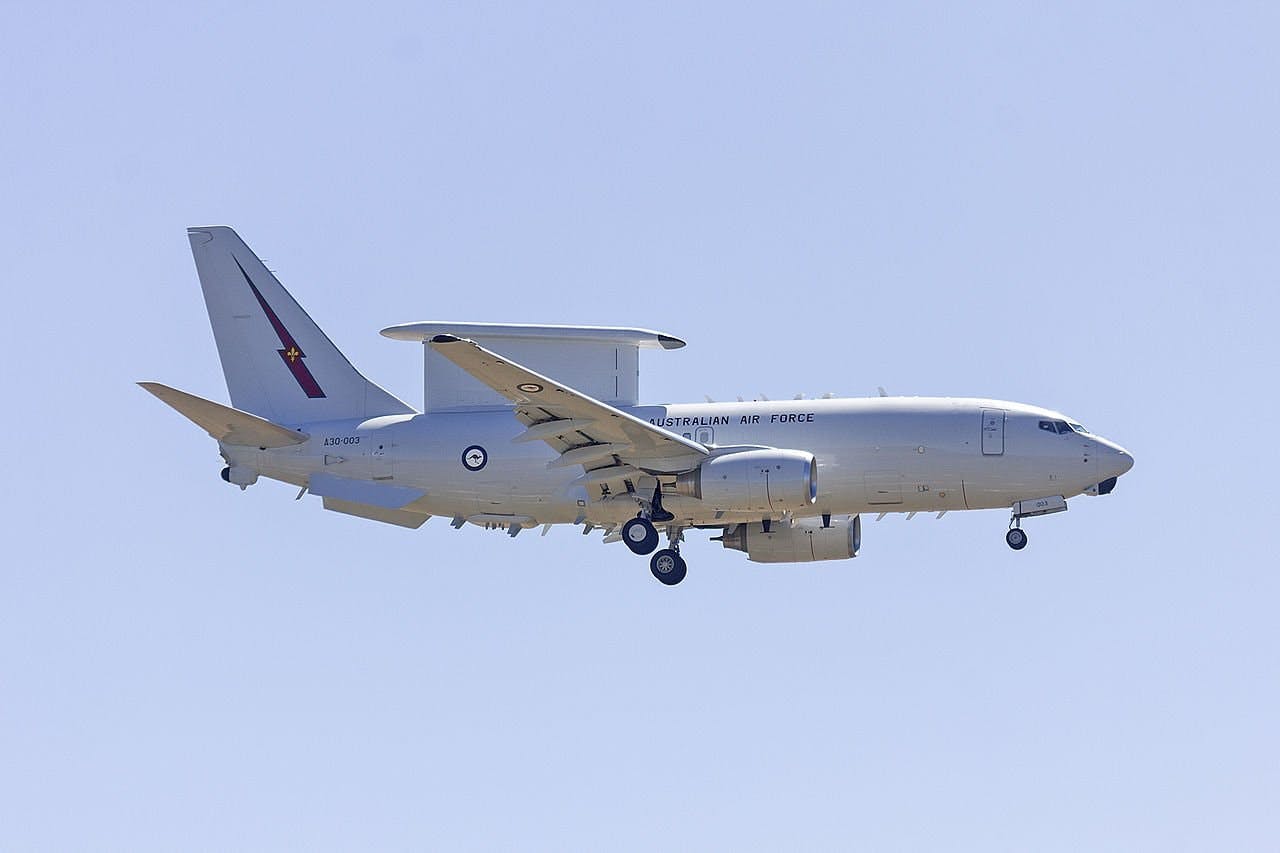
Wedgetail, in my opinion, is the only real contender short of a bespoke (and no doubt therefore expensive) platform developed for the UK.


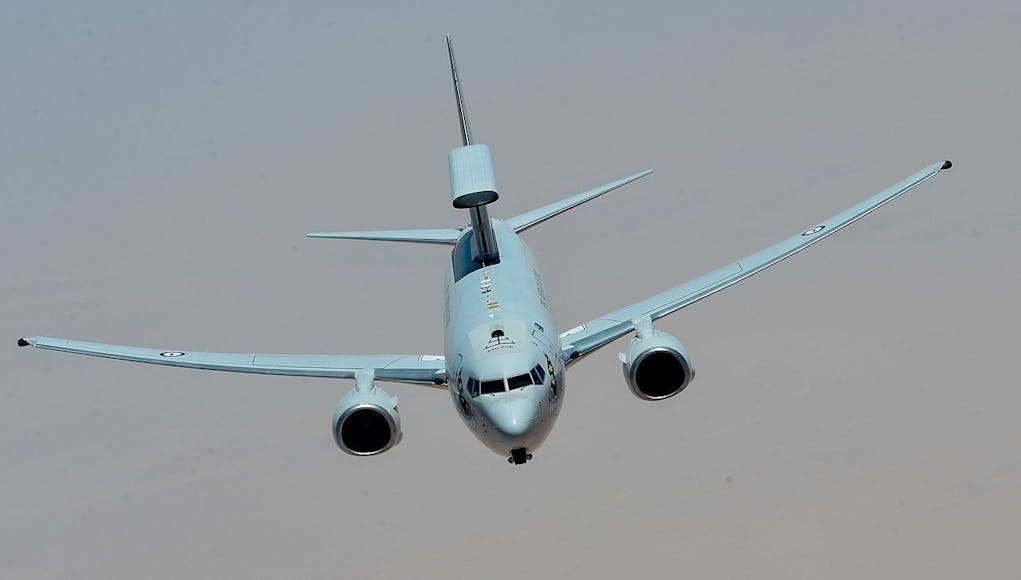




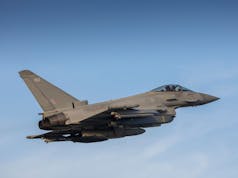

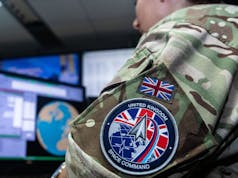
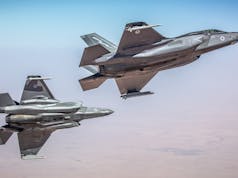
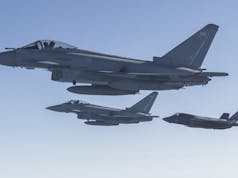


Simply yes.
Off the shelf (so cheaper) – check.
Proven and capable design – check.
Commonality with other airframes and counties – check.
Australia likely buying T26’s if we buy E7’s – check.
Ticks all the boxes in my opinion.
It looks a very promising partnership / trade.
Would Australia actually benefit much/at all from a UK buy? Depends on how any buy is structured I guess with Boeing and others. I would presume only to Australian benefit at all (if that’s even possible) should T26 be chosen. Maybe someone can illuminate better than I.
Australia owns a share of the intellectual property associated with the E7 having contributing hard coin to its development so we would expect some royalties in return for a UK sale.
But while the last 4 Wedgetails were actually converted from the green airframe in Queensland (and their might be some Australian jobs in bolting together the UK variants), it’s primarily a US product built in Boeing’s Seattle plant.
So it’s a small bonus for Australia if the UK chooses Wedgetail but in no way is it linked to the Sea 5000 frigate decision. There is absolutely no connection with the T26 – zip, zero, zilch.
Good idea specially if it sweetens T26 deal. We should look to manufacture it here as much as possible though and pay for a license to do so. Keep as much of the investment here as possible and build up capability. Commonality with Poseidon from a parts perspective also makes it a good choice.
Great sign of CANZUK!!?
Better equipped?
Remember we sent our Sentinals to help them as they did not have suitable equipment?
Not to mention heavy lift aircraft.
and Chinooks!
Indeed it’s swings and roundabouts. Carriers will be the next thing they struggle with by comparison and they have put off dealing with to save shorter term. Neither nation can sadly excell in everything and to a degree each tries go cover the others more obvious deficiencies where possible.
What does surprise me is how they can produce a home built Nuclear deterrent and have so much left over mind.
Also UK RFA is vast compared to French supply fleet. For SSN it’s also very much advantage UK – 7 vs 6 and once ours are all Astute each of our SSNs being very much bigger and more capable, something that will still be the case even after France has transitioned to their new Barracuda class.
Of course there are other areas where the French could make similar comparisons in their favour. It is swings and roundabouts with the UK stronger in some areas and France in others. It really doesn’t seem to me though to be the case that, looked at as a whole, France’s military can be so simply characterised as “larger and better equipped” than the UK’s.
Having said that, with all the pressure on our defence budget we should definitely be looking very hard at any areas where other countries are spending money more efficiently than us and try to learn lessons from it. We need to squeeze every ounce of capability that we can out of every £1 of the UK defence budget and a “not invented here”/”we know best” attitude isn’t conducive to that.
Good idea to use the P-8’s basic airframe as commonality would offer huge maintenance cost savings?
It is not quite the same air frame. The fuselage is pretty much the same (although the P8 is longer) but the wings are quite different. However the avionics will likely be much the same and the engines are the same.
Yes it makes sense as it will make maintenance cheaper and easier.
And in other news from down under the Australian Government has today finally committed budget to the purchase of the first of 6 MQ4C Triton UAVs to supplement the RAAF’s fleet of 12 P8s.
The initial $1.4 billion investment in the Triton system will also include $364 million on new facilities at RAAF Bases Edinburgh and Tindal, as well as the necessary ground control systems, support and training.
The first of the Triton aircraft is expected to be introduced into service in mid-2023 with all six aircraft to be delivered and in operation by late 2025.
Australia will also enter into a $200 million cooperative program with the United States Navy for the development, production and sustainment of the MQ-4C Triton.
Buy wedgetail to replace sentry.
As for the French armed forces their capability is far worse than ours.
The E767 that Japan uses is no different to our E3D except it uses a Boeing 767 airframe instead of the 707’s. It is still using the same radar as fitted to our E3Ds, so although it has excellent range, it still suffers from the same issues. The best option for the UK, is the Wedgetail, as most of the development issues have now been ironed out by the Aussies. The aircraft is also in service with a number of other Airforces with another couple as perspective buyers.
There is currently nothing on offer from Airbus and both the Saab Erieye and IAI EL/W-2085 has too short a range for both the airframe and the radar to meet our needs.
The only other option is for us to develop a completely new system, but I don’t think we have the money or time to do this!
(Chris H) We really should know by now this ‘TH’ is just a wind up Troll and should be ignored. Don’t give the fool the oxygen of argument. His comment has the square root of sod all to do with the article or Wedgetail aircraft.
(Chris H) TH – Oh dear Sweetcheeks did I touch a nerve? As Oscar Wilde was once moved to observe:
“Abuse remains the refuge of the witless”
And you Sir are without any wit whatsoever ….
TH – Even if that was true (nice try though) its somewhat better than the verbal diarrhoea you force us to endure with your continual negativity and trolling completely out of context let alone on the subject matter in hand. Witness your gobbing off here about French military being better than ours when the article is about Aussie Wedgetail aircraft.
But thanks for proving dear old Oscar correct…..
they probably don’t have a terribly corrupt and expensive procurement chain like us. their troops seem to have all the right kit and their command don’t seem to be solely along for a jolly good time in the mess.
(Chris H) I know I shouldn’t but I can’t resist:
Precisely what, if any, aircraft does the French Air Force operate that is in any way better than that operated by the RAF?
In fairness Chris, The Rafaela and Typhoon are the same. A400 are the same, many of the missiles are the same.
Probably not your best argument.
I agree with TH on this (to a point) the French get more for their money.
Any idea just how many civil servants lost lap tops when compared to military personnel?
Hi Gents!
I’m not fully aware but how about
Saab GLOBALEYE?
Definitely maintaining will be cheaper than any other options. And guess endurance is better.
Commonality with P-8, at least the engines and avionics (and maybe other stuff like landing gear, control surface actuators, fuel pumps etc?) plus the Australian tie-in seem to me to be two very big positives such that any contender would need to offer significantly more in other areas in order to tip the balance in its favour. I’m sure Globaleye is good but is it good enough to tip the balance in its favour? I’m not sure on that one.
For duration Wikipedia quotes 11 hours for Globaleye and I just found a Nov 2015 article that reports…
“A Royal Australian Air Force E-7A Wedgetail airborne early warning and control platform has set a new record by flying a 17-hour operational mission over Iraq and Syria, Defence stated on November 11”
I found that article by simply googling “wedgetail duration” and it was the first hit. The link didn’t actually work for me (site wouldn’t load) so I had to access the content by clicking the down-arrow to the right of the link and going to Google’s cached version to extract the quote above but here’s the link that I couldn’t get to load in case others have better luck than me – https://australianaviation.com.au/2015/11/wedgetail-sets-mission-duration-record/
It clearly says they refuled twice in the air to achive this 17 hours flight…
The Saab plane has twice the range of the Wedgetail.
I wished to see it on Farnborough 2018 in reality but unfortunately it was just picture on Saab pavilion’s wall over there. Probably it might be inside but didn’t see any mention about it during weekdays. Definitely it might be cheaper to maintain but many things have to be considered. Shared platform, integration and etc.
Unless we are willing to apply some serious ingenuity and create a whole new concept that would then create some serious exports, we should buy off the shelf. But I doubt we either have the money or the stomach after nimrod to stick our neck out and do something original. It would be great to do something that utilises a large drone platform and is used in numbers to create a network that can cover a far larger area and utilise off board processing of data.
surely Britain would buy wedgetails for no other considerations other than it is the best for their needs
The Nimrod AEW when it was working was actually a better radar than the E3Ds AN/APY-2, as it had better range and resolution. The problems it faced were that the airframe was too small for the number of 1980s size computers required for the signal processing which caused massive overheating issues. The other major headache was syncing the front and rear mechanical antenna to provide a continuous sweep. The radar made a major discovery in the form of real time ground mapping with for the time very good target resolution. This discovery eventually led to the very successful Sentinal program using synthetic aperture techniques for target mapping first used on the Nimrod AEW. So it wasn’t a complete waste of money.
This country has constantly proved that we are innovators, just wish there was the will and funding to back it up, rather than selling/giving away our ideas! We have the skills to build the radar and develop it on to a suitable airframe, just need to do it!
Knowing how much the MoD is capable of wasting money I fully expect them to ignore the obvious in buying OTS and modify Sentry at ruinous cost.
But I hope they buy this instead.
The Nimrod AEW when working proved to have better range and target resolution than the current AN/APY-2 as fitted to the E3D. Further a rather staggering finding was made with the radar when using MTI in the synthetic apeture resolution mode. This was real time ground target mapping. For 1980 tech this was bit of a revelation as it showed by 1980s standards near photo resolution. However, the program suffered many issues with cooling of the computers needed for the signal processing. The Nimrod’s airframe was too small to incorporate sufficient cooling for the computers, so they’d just overheat and crash. The other main problem was trying to synchronise the front and rear mechanical antenna to give a continuous uninterrupted sweep.
The program did lead to the development of the awesome Sentinel aircraft. But that uses a fixed AESA radar and modern computers for signal processing.
Our country has always had the genius to be creative, we just suffer the lack of will and funding to turn it into reality. We have the capability to build a World leading airborne radar system. We just need the will (and funding) to build it!
(Chris H) DaveyB – Absolutely and totally agree with that sentiment Sir. Somewhere along the way we seem to have lost our ability to believe in ourselves. When you look at how much the UK has given the world in aerospace and related technology and where this country led the world not so long ago it isn’t because we can’t its just because we don’t believe we can. And that is compounded by those in power who think foreign is better just because its foreign which disadvantages home grown talent and becomes a self fulfilling prophecy. Sometimes it is but often it isn’t. And building at home will always be more cost effective if not ‘cheaper’ (but thats another discussion).
Building at home is not always cheaper. It depends on how many we are buying and how many jobs it supports etc. Quite often it can be best to build here but there are times it is better to get off the shelf equipment.
(Chris H) Lee1 – As I said that is another discussion but basically the point is whatever is actually spent here probably some 50% of all of the ‘cost’ is recycled back to the Government in Income Tax, Corporation Tax, Council Tax, Business rates, VAT etc. That is then repeated all down the supply chain. And the wages paid to employees is then also spread around the local and national economy in food fuel and other purchases, mortgages, transport etc
Any purchases from abroad are total loss costs. The evaluation in Whitehall needs to change from ‘Price’ to ‘Nett Cost’ and then see how ‘competitive’ the likes of Korea really are.
And did it occur to you TH that the French armed forces are deficient in other areas and require support of the UK? Off the top of my head I can list heavy transport that they need from us for their ops in Africa and their entire fleet, as listed in their own white paper where they themsleves state they won’t be able to commit to large naval manouveres without the royal Navy to support.
Honestly TH you’re just a troll with zero knowledge of military matters who just copy pastes comments. I’ve seen your French effiency post twenty times now. You’re truly pathetic.
Hey TH
I think you add value to this forum and I respect your opinion
Why the aggressive attitude lately?
You know your views are in the minority on this forum and people do treat you with respect I believe.
TH is one of many russian trolls ,its just that he has been assigned to this website ,he should just be ignored.
We’ll see. UK’s military unfortunately took a large beating in Afghanistan and Iraq compared to France.
UK’s military reputation took a heavy beating in Afgan/Iraq, not sure you can compare things military wise, since France didn’t committee same number of troops or undertake as risky operations.
I wonder if UK could get a E-7 which based on the p-8 rather than the normal 737?
Can I opine that I believe that any current large, non stealth, high EME radiating airborne system is basically as doomed as a duck in the tub in today’s threat environment? Even more so in the future? Unmanned would be the only safe way of operating anything of that category to literally save the lives of aircrew…
Helions quickly gets behind his magic ballistic shied…
Cheers!
Fair comment and I agree
I think we should go for a UAV and increase the P8 fleet.
Personal opinion. But for me a taranis with all the kit is the way to go…
British all the way and a force multiplier
Aegis I mean… Tiny keyboard! 😀
Force multipliers are always going to be the primary target of any conflict, so from an RAF prospective it includes the Sentry’s, Sentinels, Rivet Joint, Poseidon and especially the Voyager tankers. Yes there is a risk to the aircraft involved, but the risk is much higher when not having these aircraft up in the air. There will come a time when the 1st line will be composed of UAVs with manned aircraft either controlling them or backing them up. By placing the shooting aircraft in such a position the force multipling aircraft “should” be safe and shielded!
The tracking capability is quoted as 180 targets. This is a very low number for a modern battlespace which will contain a lot of civilian aircraft and civilian shipping – the wedgetail is looking at over 1.1M square kilometers all the time.
What is the reason that the US air force has not replaced their sentry with the wedgetail?
Considering they have almost bottomless budget in comparison, it does make you wonder if the wedgetail is as good as sold when compared to the sentry.
(Chris H) Steve – One simple answer to that – Its not American so therefore it has no value in their eyes
The RAF needs to a boom equipped voyage to make the most of the E-7 and P8
The E7 is the obvious choice for the RAF, especially in light of their T26 purchase.
Look at the Australian requirements, sanitising huge tracts of airspace, not unlike our needs when you factor in the huge areas of over sea airspace we need to patrol.
The Australians have paid for the bulk of the development and have de risked the platform.
Total no brainer, order 6 now for delivery from 2020.
Waiting for the “Airbus A320/21 solution” gang to pipe up with an expensive European solution for reinventing the wheel…
Don’t expect Airbus to want to get involved with another Large Military aircraft program any time soon , especially after the way they have been shafted over the A400 partner nation annual procurement numbers.
I’m always amazed at how any subject is quickly turned into a war between what we do and the French. Guys, we’re not fighting the French (nor the Germans for that matter)! They’re our allies! Both forces complement each other well. In some areas U.K. has an advantage and we work together well. The French, btw, don’t get more for their money. They just use it better. I lived eight years there and had close relations with the DGA (French DE&S). The main difference is that once they make a decision, they don’t keep revisiting it, changing it, questioning it, wanting to cancel what the previous government did, etc., etc. They just power ahead, stick to it come hell or high water and on average get better (and cheaper) results in the long run than U.K. does. And we shouldn’t lay all the blame at DE&S’ door. They’re actually quite good at what they do. It’s the senior Service Staffs and politicians to quibble, bicker and can never make up their minds. Sentry replacement will be just the same. Wedgetail is the obvious no-brainier solution. The RAF has known this for some time. But watch them prevaricate and look up the sex of angels for years to come, before doing something. It’s the length of time that costs tax payers’ money. As for the Australians, I continue to be amazed at the capability they are amassing and the common sense defence decisions they continue to make. They’re now adding a Triton buy to their P-8 procurement. Real cutting edge stuff. And they paid the money and suffered the pain of buying a Voyager with both hose and drogue and boom refuelling systems. Now they have a truly world leading capability there.
Would it be so mad to use Sampson radar variant nose and aft? And an a330? Might actually produce a world leading system?
Curious as to lack of 360 coverage particularly from the front is a big issue tactically, I would have thought not being able to fly and scan in the direction you are expecting the theat to come from would be an issue. Also modern fighter radars are getting close on performance and harder to see( although Am only going on internet knowlage) what the impact on this in terms of a like for like replacement.
“The system provides 360 degree coverage and is capable of simultaneous air and sea search, fighter control and area search, with a maximum range of over 600km (look-up mode).”
As the array is mounted sade facing its difficult to understand how this is achieved
Actually being based off of a common commercial airframe has seen these things have bloody cheap and fast turn around times when maintenance is required.
The array is long yes but there are still 4 side to it. 2 sides are simply thinner then the others. They still perform the radar role though.
“Actually being based off of a common commercial airframe has seen these things have bloody cheap and fast turn around times when maintenance is required.”
Ignore that, part of anither reply didnt send lol.
There have been an awful lot of articles like this recently (well, really just the one article constantly re-hashed). I’m amazed at how little coverage the ELTA G550 CAEW gets in this discussion (and indeed in the oft cited RUSI paper). It has already been delivered to a number of nations and 2 are in service with NATO member Italy with whom it has demonstrated interoperability with both Typhoon and F-35 ( article here for info on the relevant exercise https://theaviationist.com/2018/05/23/exercise-joint-stars-2018-put-italian-armed-forces-most-advanced-hardware-to-test/ ). Also, unlike globalEye, it has a 360 degree radar!